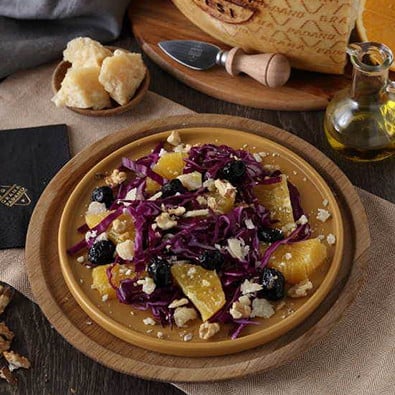
Gnocchi with meat ragù and Grana Padano petals
6 people
Chef Francesca D’Orazio
An important dish for the Sunday before Carnival, like this one, is potato dumplings – gnocchi – even better when they’re homemade – seasoned with a rich, traditional, slow cooked ragù. The ragù described here is Neapolitan style, which differs from the Bolognese mainly on the size of the meat: minced meat in the Bolognese style, and large pieces in the Neapolitan one.
Ingredients
- For the gnocchi:
- 1.4 kg potatoes
- 300 g flour
- 50 g Grana Padano PDO, grated
- salt
- extra flour for dusting
- For the ragù:
- 500 g veal (in one piece)
- 500 g pork (in one piece, not too lean, ideally from the neck)
- 1 glass of white wine
- 1.5 l tomato purée
- 1 onion
- 1 celery stick
- 1 carrot
- 1 bay leaf
- 3-4 parsley stalks, without leaves
- extra virgin olive oil
- salt
- chili peppers
- Grated Grana Padano PDO and some thin slices of Grana Padano cheese (you can cut the slices using a potato peeler or cheese slicer).
Preparation
To make the ragù:
In a large casserole dish, sear well the two pieces of meat on each side with a little olive oil. Remove the meat and clean the casserole dish using a piece of paper towel to absorb the fat. Pour in 3-4 tablespoons of olive oil, the onion, celery and the carrot cut into large pieces. After browning the vegetables, replace the meat into the dish. Once reheated, pour the white wine over the sides of the dish and leave to evaporate over high heat.
Pour in the tomato purée, then add the bay leaves and parsley stalks, bring to a boil, lower the heat and cook over a very low heat for at least two hours, stirring occasionally, while the ragù is thickening. Salt when halfway through cooking and check your seasoning again later.Remove the meat and leave to rest, then slice and place it on a serving dish. The meat will be served separately, as a second course.
To make the gnocchi:
Wash the potatoes, put them in a pan and cover with cold water, bring to a boil, lower the heat and cook for about 40 more minutes (depending on the size of the potatoes).
Peel, then mash them using a potato-ricer.
Place the mash on a work surface, spread it out and leave to cool. Add in the grated Grana Padano and 3/4 of the flour, mix together until the dough has have a soft, non-sticky texture, adding the remaining flour, a little at a time, if necessary.
Divide the dough into several pieces. Flour and roll each piece, then cut them into 2 cm pieces. Arrange them on a floured tray.
Cook the gnocchi, a few at a time, in a pot abundantly full of boiling salted water.
Drain them gradually, using a slotted spoon, and season with the ragù.
Serve together with grated Grana Padano cheese and – for those who wish – some chili peppers.












